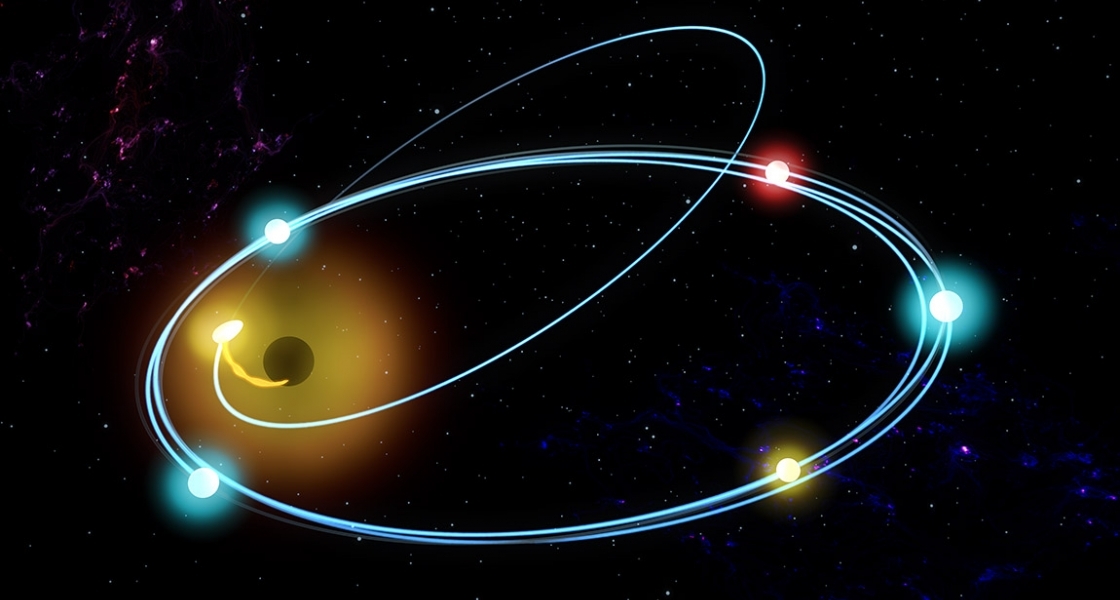As the original maps, calendar, and fortune tellers, stars have forever complemented our nightly imaginations with their consistent patterns. But like everything, they too come and go. Sometimes they fade with a peaceful final twinkle, but other times, they’re destroyed in violent calamity.
When a star ventures too close to a black hole, gravitational forces can stretch the once brilliant ball of light like taffy in what is called a tidal disruption event, or TDE. The stretch eventually rips the star apart, pulling some into the abyss and leaving merely debris to circle the drain.
At JILA, astrophysicists have been simulating TDEs in an effort to understand not only why these events occur, but how often. Recently, they made a simple-yet-promising model more realistic by including the effects of general relativity. And while the researchers expected general relativity to destroy all promise, they were happily surprised to find their model still stands.
TDEs were predicted decades ago as the inevitable outcome of a star that ventures too close to a black hole. But since the first, and subsequently many, detections, we’ve noticed their occurrence is much more frequent than first predicted. This discrepancy challenges our understanding of not only TDEs, but possibly even our universe.
Yet one simple solution, proposed by JILA Fellow Ann-Marie Madigan, is that TDEs occur more often than first predicted because eccentric nuclear disks are more common than first predicted.
Eccentric nuclear disk is a term that describes an entire group of stars closely orbiting a black hole in flat, elongated paths, like stellar race cars with a daredevil mindset. While once thought be exotic (the prevailing picture today is that most black holes host a ball of randomly orbiting stars), there is evidence suggesting they might be common. In 1995, researchers discovered that our nearest neighbor, the Andromeda Galaxy, hosts an eccentric nuclear disk at its center.
Vital to Madigan’s solution, however, is the idea that TDEs can occur in eccentric nuclear disks. And so, last year Madigan and her team modeled a basic eccentric nuclear disk. They found that TDEs do occur, and quite frequently.
But Heather Wernke, part of Madigan’s team and JILA graduate student in astrophysics, points out that this original simulation wasn’t realistic.
“You want to make sure understand the basic idea before you start adding in complications,” said Wernke. “Once you understand the basic physics, then you add things in to make it more realistic.”
And according to Wernke, one of the most striking deficiencies of the original model was a lack of general relativity.
“A black hole is general relativistic, so these stars will feel the effect of that general relativity anytime they get close.”
General relativity amends our original picture of gravity—the force which pulled Newton’s apple downward—as arising from the curvature of spacetime. Because black holes are so massive, their dominating force is gravity. Our researchers therefore expected general relativistic effects to significantly modify their TDE-predicting simulations.
And by modify, the researchers meant destroy. Wernke said that general relativistic effects usually round-out an orbit, or make it less eccentric. This rounding would suppress the orbital torques, which are the primary cause of TDEs.
“We thought that general relativistic precession would totally kill the TDE rate,” she said, “but it turns out it didn’t.”
In fact, after simulating the eccentric nuclear disks both with and without general relativity, Wernke found the orbits looked statistically the same. “It was very surprising.”
Wernke believes the TDEs still occur because the orbital torques work on timescales much too fast for general relativity to suppress.
And not only are Wernke’s simulated TDEs occurring too fast to be suppressed, they are occurring so often that their debris might entangle.
“You could have two TDEs occur close enough in time that their debris steams cross. We don’t know exactly what that would like, but it could be observationally really cool.”
Having passed the first test of realism, eccentric nuclear disks are still a strong candidate for the explanation of frequent TDEs. But Wernke said the next step is to make the eccentric nuclear disk simulations even more realistic, this time by varying the mass of the stars. “In the simulations that I’ve done, it’s all equal-mass stars… but other people in our group are adding in different mass populations.”
And as for Wernke, she is now focused on visualizing an eccentric nuclear disk. “What would it look like if we saw this in the sky? Knowing this will help us determine how common they are in the local universe.”
This research was published in The Astrophysical Journal on 23 July 2019.
Written by Catherine Klauss




